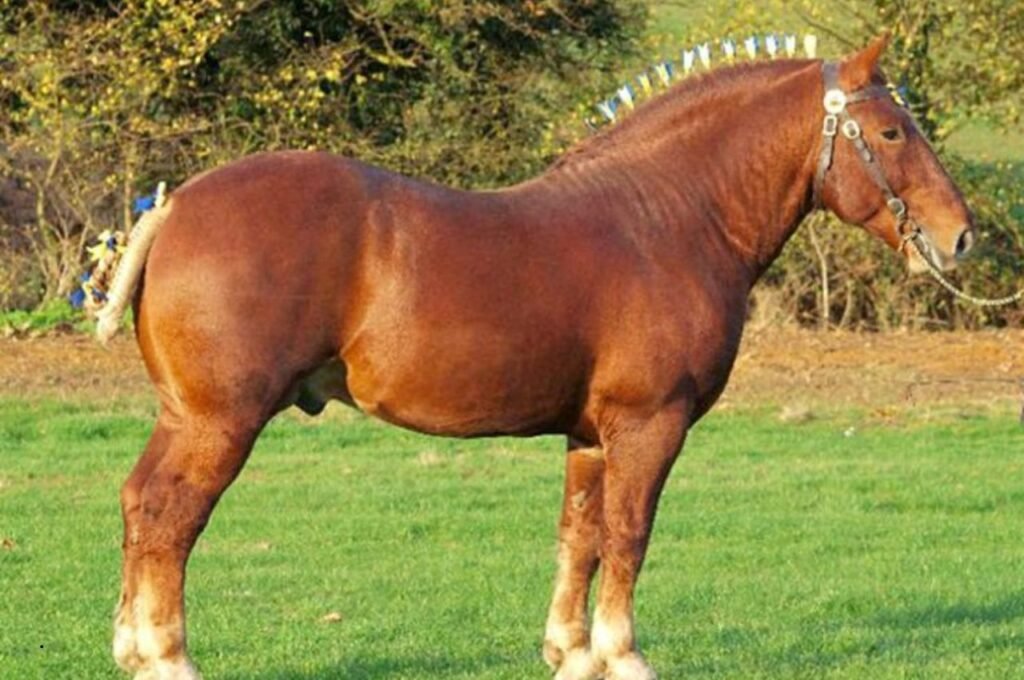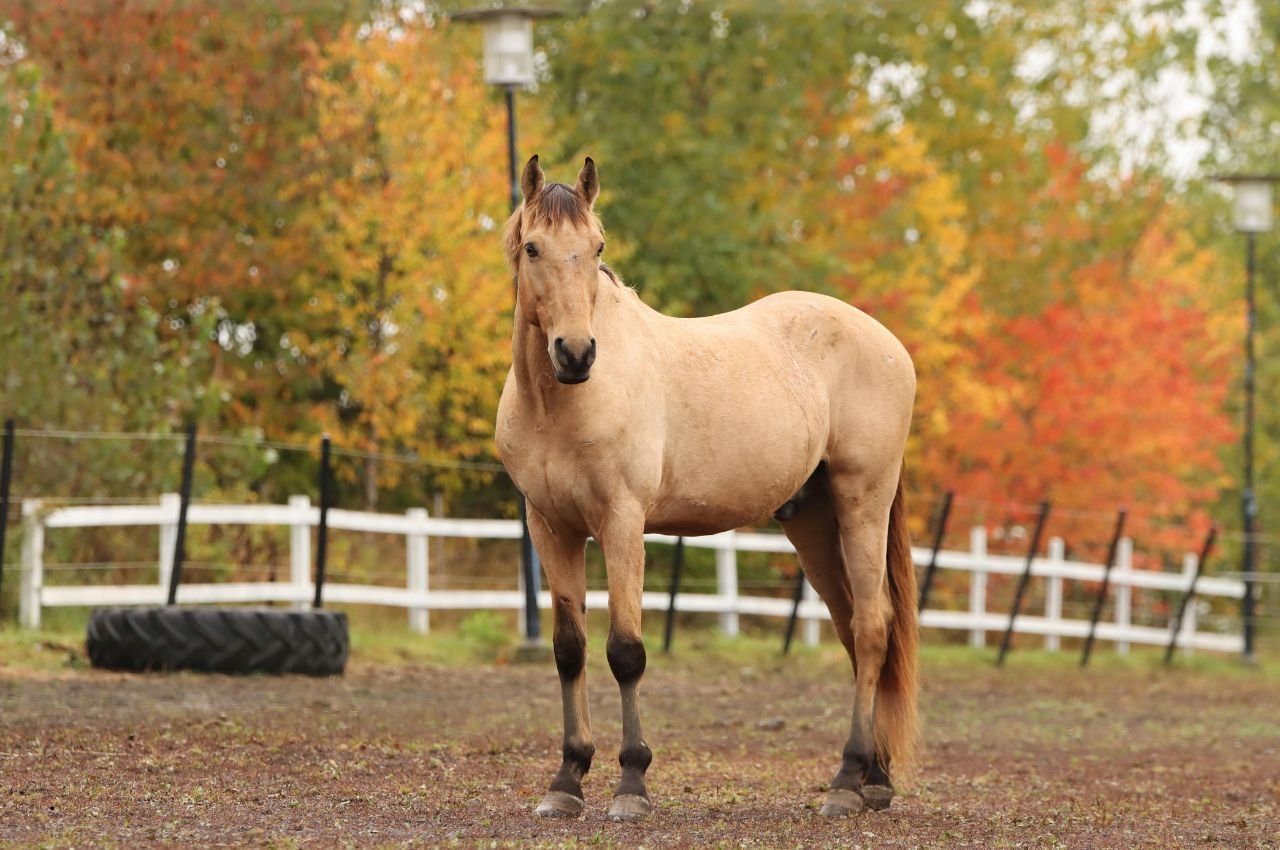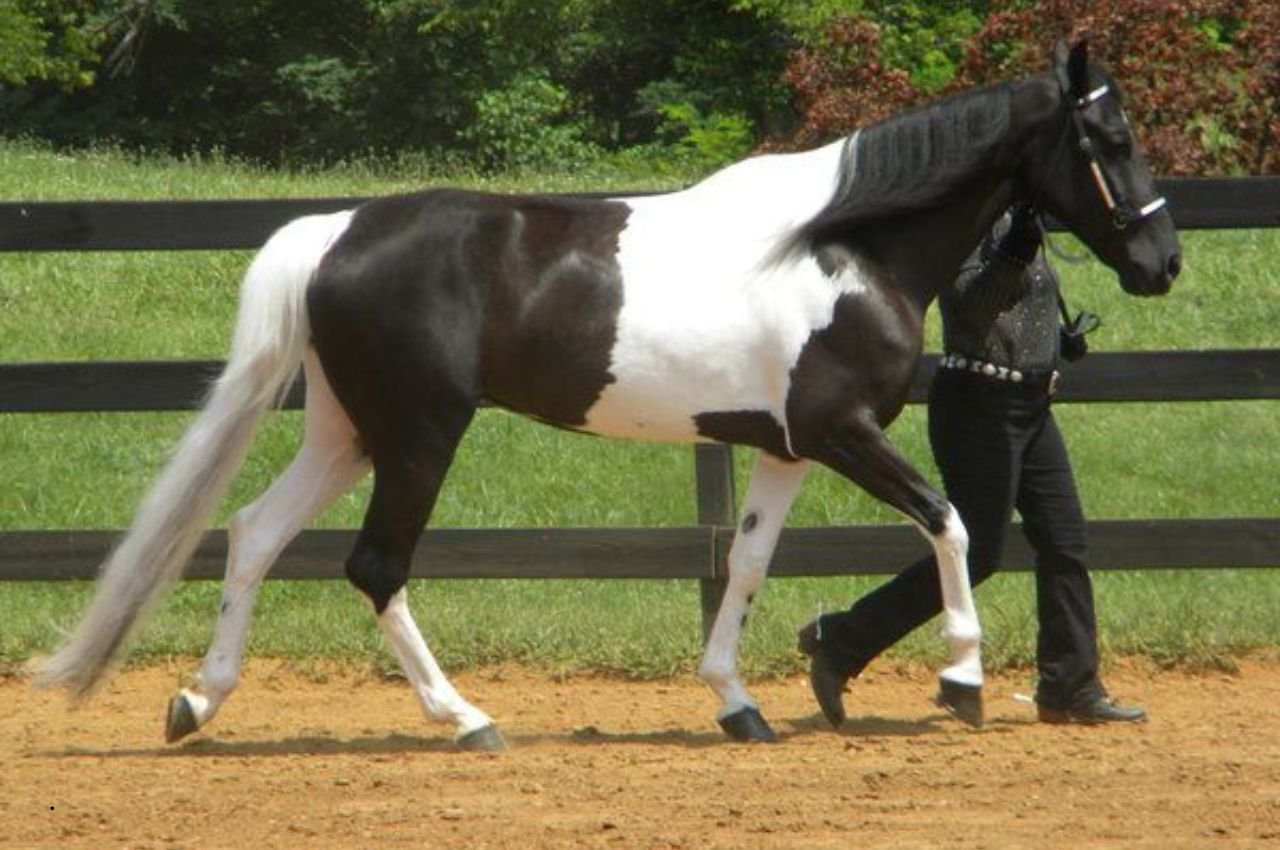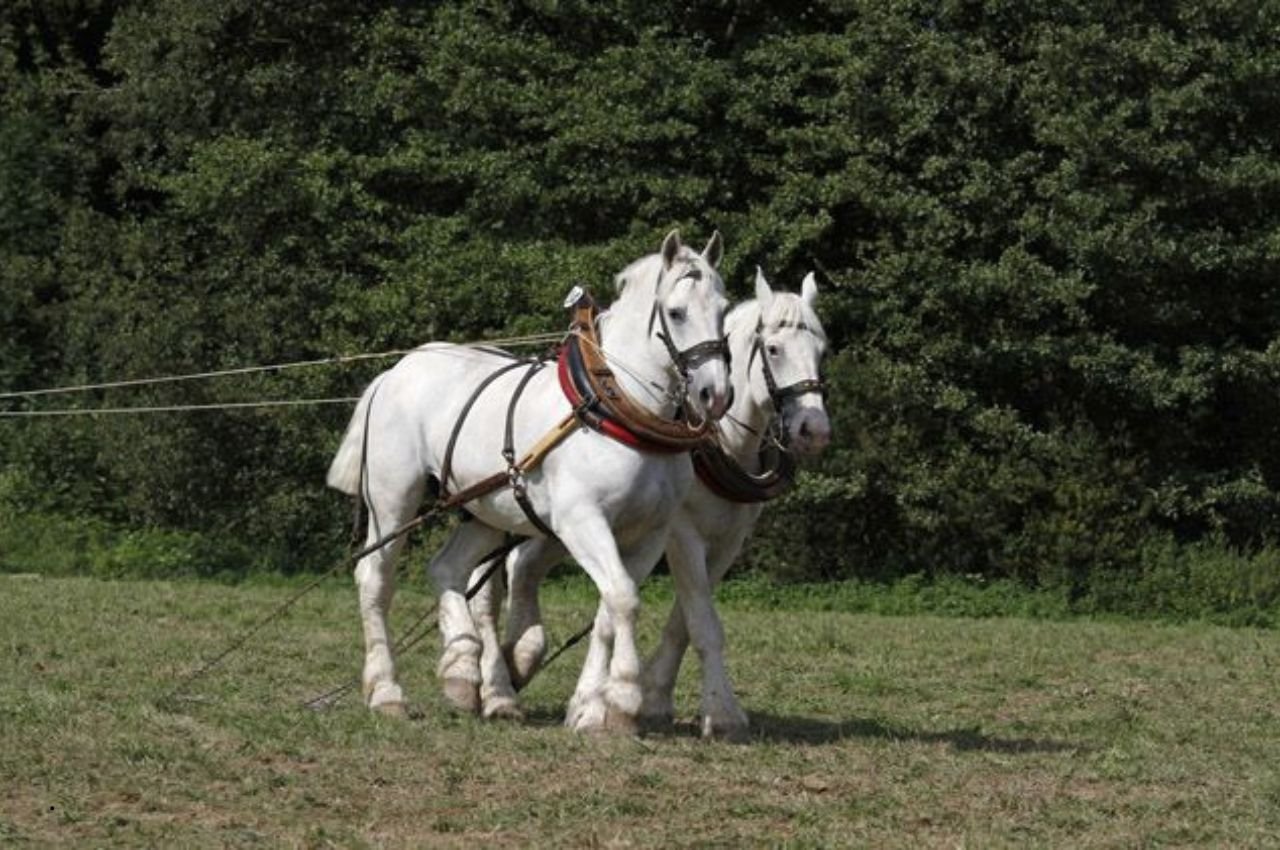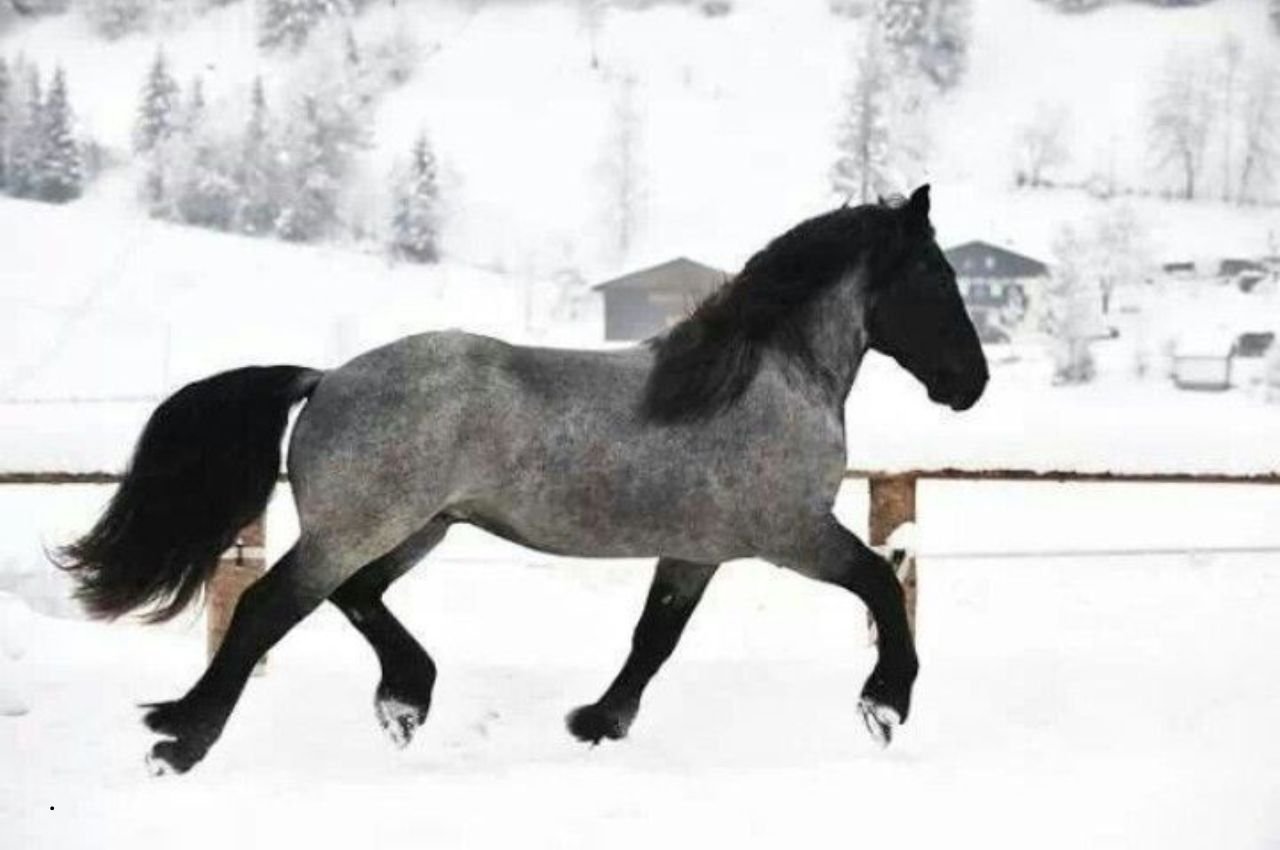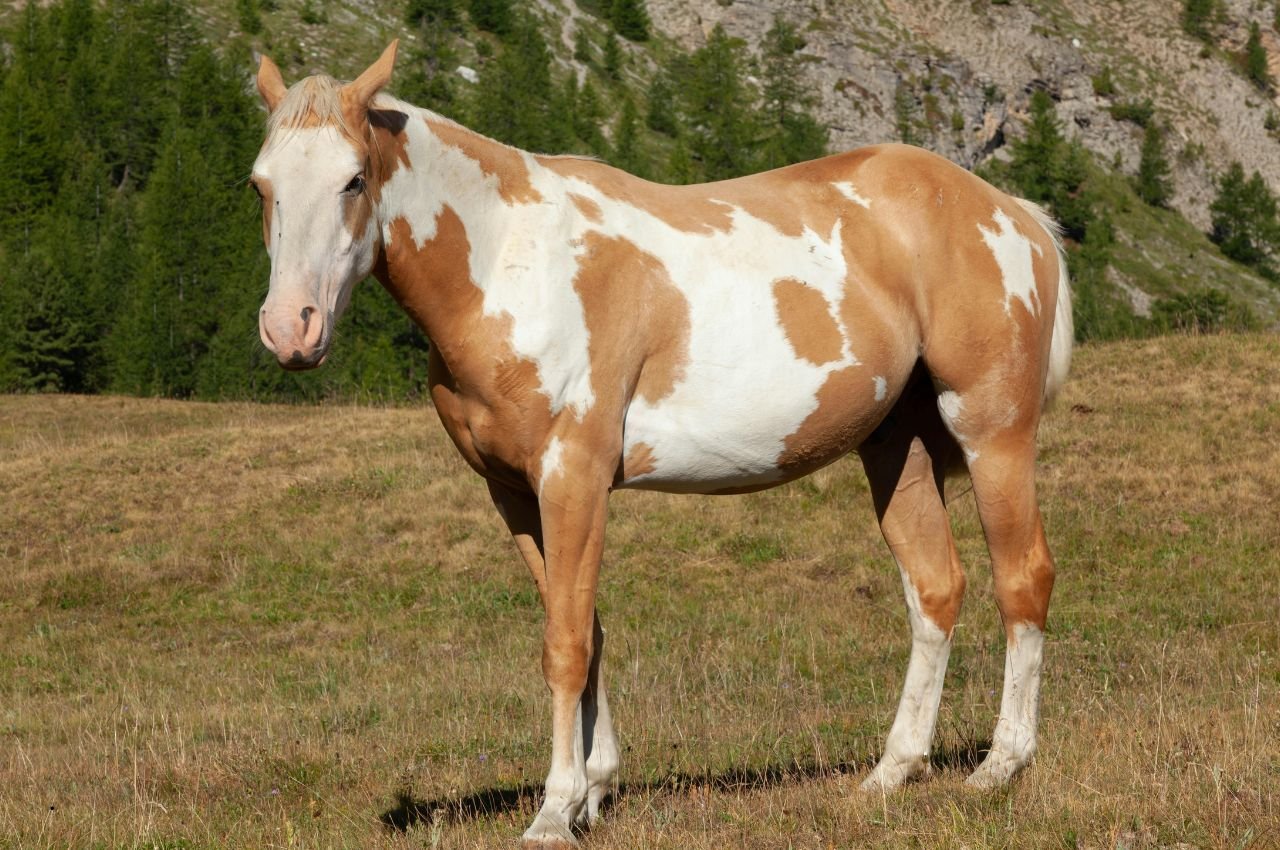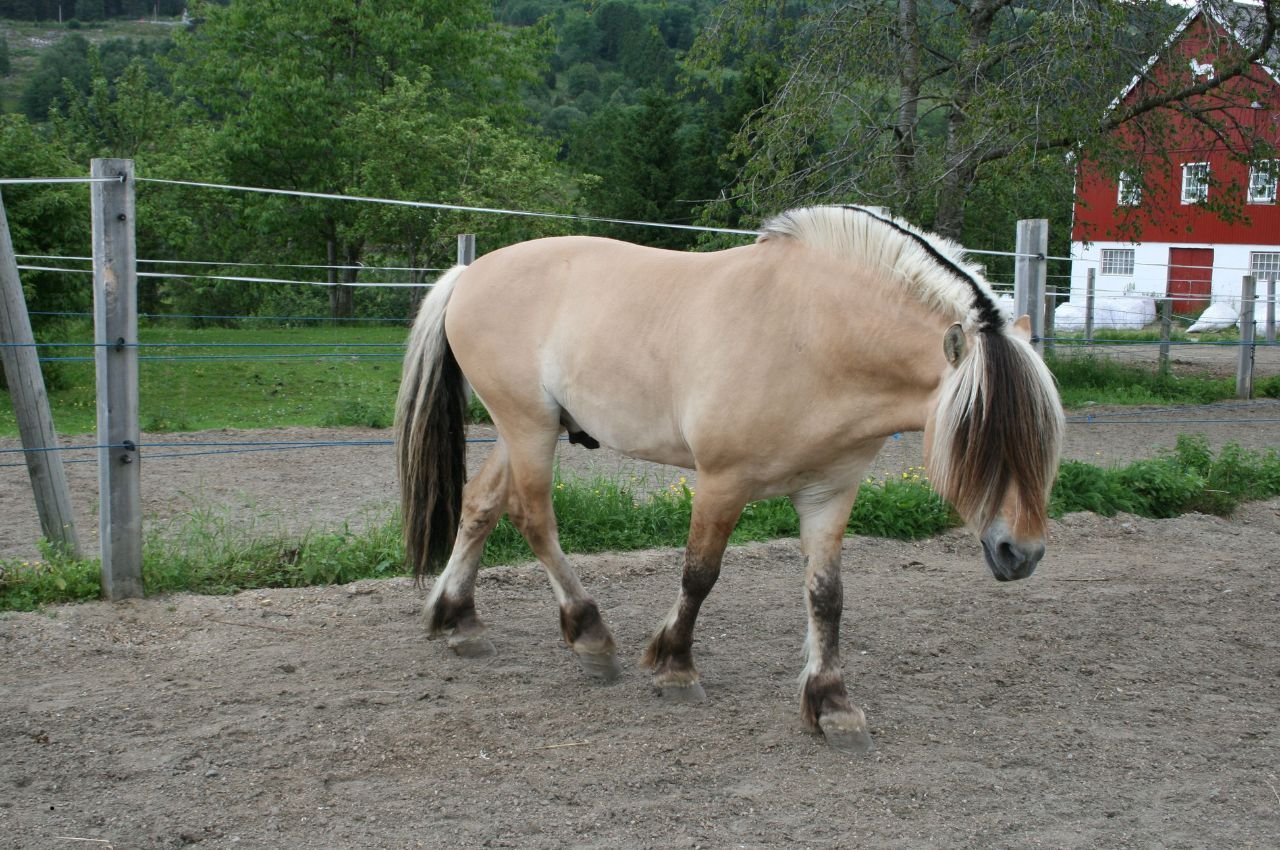The Suffolk Punch Horse stands as one of England’s most distinguished and historically significant draft breeds, representing centuries of careful breeding dedicated to agricultural excellence. The Suffolk Punch is the only draft breed in history developed exclusively for farm work, making them uniquely specialized among the world’s heavy horses. This remarkable breed embodies the perfect fusion of power, stamina, and gentle temperament that made them indispensable partners in traditional English agriculture.
What truly distinguishes the Suffolk Punch from other heavy draft horses is their exclusive chestnut coloring – The Suffolk Punch breed exhibits seven different shades of “chesnut” (the preferred old-style spelling) – and their remarkable efficiency as workers. The breed tends to mature early and be long-lived, and is economical to keep, needing less feed than other horses of similar type and size. Their legendary work ethic has made them icons of sustainable farming practices, where their willing nature and endurance have proven invaluable for generations of farmers.
Historical Heritage and Development
The fascinating heritage of the Suffolk Punch spans over 500 years of continuous breeding in the English county of Suffolk, making it one of the oldest and most genetically consistent horse breeds in the world. In his History and Antiquities of Hawsted, in the County of Suffolk of 1784, Sir John Cullum describes the Suffolk Punch as “… generally about 15 hands high, of a remarkably short and compact make; their legs bony; and their shoulders loaded with flesh. Their colour is often of a light sorrel”.
Ancient Origins and Foundation
The Suffolk Punch’s development began in the 16th century when English farmers in the county of Suffolk recognized the need for a specialized agricultural horse capable of working the region’s heavy clay soils. Unlike other draft breeds that evolved from war horses or general-purpose animals, The Suffolk Punch was originally bred for farm work by local farmers, who needed a horse with power, stamina and docility – traits which endure in the Suffolk Punch to this day.
The breed’s foundation reflects the practical needs of Suffolk farmers who required horses that could work long hours in challenging conditions while remaining economical to maintain. As a result, the breed retains characteristics relevant to the breeding choices that were made including the strength and stamina to plow through heavy clay, hardiness, a willing disposition, and easy-keeping qualities.
The Crisp’s Horse Foundation
All modern Suffolk Punch horses can trace their lineage back to a single stallion known as Crisp’s Horse, foaled in 1768. This remarkable genetic bottleneck, rather than weakening the breed, actually strengthened it by establishing consistent characteristics that have been maintained for over 250 years. The careful breeding program that followed ensured that the desirable traits of power, docility, and efficiency were preserved and enhanced.
The Suffolk Punch Registry is the oldest English breed society, established to maintain breed purity and record breeding activities. This early organization demonstrates the value placed on maintaining breed integrity and the systematic approach taken to preserve the Suffolk Punch’s unique characteristics.
International Expansion and Decline
Suffolk horses were first imported to Canada in 1865 and to the United States shortly thereafter, where they found eager markets among farmers dealing with heavy soils similar to those in Suffolk. The breed’s reputation for hard work and efficiency made them popular throughout North America during the height of horse-powered agriculture.
However, the mechanization of agriculture in the 20th century brought dramatic challenges to the breed’s survival. By the 1960s the population of Suffolk Horses had fallen to such an extent that only nine foals were registered in the Stud Book in 1966. This near-extinction event galvanized conservation efforts and highlighted the breed’s critical endangered status.
Modern Conservation Efforts
Today, the Suffolk Punch is recognized as one of the world’s rarest horse breeds, with dedicated conservation programs working to ensure its survival. The Suffolk Punch Trust is a charity dedicated to help protect the critically endangered Suffolk Punch horse breed through its established breeding programme. These efforts focus on maintaining genetic diversity while preserving the characteristics that made the breed successful.
Physical Characteristics and Conformation
The Suffolk Punch presents a distinctive and immediately recognizable appearance that reflects centuries of selective breeding for agricultural work. The breed has a powerful, arching neck; well-muscled, sloping shoulders; a short, wide back; and a muscular, broad croup. Every aspect of their conformation serves the practical purpose of maximizing pulling power while maintaining the stamina necessary for sustained agricultural work.
Size and Build Specifications
Mares are 16.1 to 16.2 hand high and stallions are 17 to 17.1 hands high, placing them in the medium to large category among draft horses. Their weight typically ranges from 1,600 to 2,000 pounds, with this substantial mass distributed across a compact, powerful frame that emphasizes efficiency over sheer size.
The breed’s conformation standards reflect their specialized purpose as farm horses. Unlike some draft breeds developed for size or appearance, every aspect of Suffolk Punch conformation serves the practical needs of agricultural work, creating horses that are both powerful and efficient.
Distinctive Color Requirements
Their color has to be chestnut or sorrel, little markings on their face, and their coloring pales on their legs. This strict color requirement is unique among draft breeds and reflects the breed’s genetic consistency. The seven recognized shades range from light chestnut to dark liver chestnut, each with its own traditional designation that reflects the breed’s English heritage.
The consistency of color within the breed demonstrates the effectiveness of the selective breeding programs that created the Suffolk Punch. Unlike breeds that accept multiple colors, the Suffolk Punch’s uniform chestnut appearance reflects genetic stability and helps maintain breed identity.
Body Structure and Movement
Legs are short and strong, with broad joints; sound, well-formed hooves; and little or no feathering on the fetlocks. This clean-legged appearance distinguishes them from feathered draft breeds like Clydesdales or Shires, reflecting their development in the relatively dry conditions of eastern England.
The movement of the Suffolk Punch is said to be energetic, especially at the trot. This active movement pattern reflects their breeding for efficiency and endurance rather than mere size or strength. Their smooth, ground-covering gaits make them pleasant to work with while conserving energy during long working days.
Functional Conformation Features
The breed’s short back and powerful hindquarters provide the structural strength necessary for heavy pulling work while maintaining the balance needed for sustained effort. Their well-muscled shoulders and powerful neck allow for efficient power transmission through draft harness while distributing load forces throughout their frame.
The Suffolk Punch’s compact build makes them particularly suitable for working in confined spaces and navigating the narrow lanes and small fields typical of English agriculture. This maneuverability, combined with their power, made them ideal for the intensive farming systems that developed in Suffolk.
Temperament and Character Traits
The Suffolk Punch Horse possesses a temperament that perfectly complements their physical capabilities, combining the power necessary for heavy work with the intelligence and docility required for safe, efficient cooperation with human handlers. They were also bred for their good disposition and willingness to work with great endurance and heart.
Mental and Emotional Characteristics
To plow the heavy clay soil they needed an agricultural horse with power, but also stamina, health, longevity, and docility. This combination of traits reflects the careful selection that created the breed, prioritizing not just physical capabilities but also mental suitability for farm work.
The breed’s intelligence manifests in their ability to learn complex tasks quickly and work independently when necessary. Suffolk Punch horses often demonstrate what horsemen call “horse sense” – the ability to anticipate work requirements and adapt to changing conditions without constant direction from their handlers.
Work Ethic and Dedication
They are hard workers, said to be willing to “pull a heavily laden wagon till [they] dropped.” This legendary work ethic has made the Suffolk Punch famous among working horse enthusiasts and agricultural historians who recognize the breed’s contribution to English farming success.
Their dedication to work extends beyond mere willingness to the development of genuine partnership with their handlers. Suffolk Punch horses typically form strong bonds with their caretakers and demonstrate loyalty and cooperation that makes them exceptional farm horses.
Gentle Nature and Tractability
The breed’s docile nature makes them particularly suitable for handlers of varying experience levels, from professional teamsters to farm families where children might interact with the horses. This gentleness doesn’t indicate weakness but rather reflects the confident, secure temperament that comes from centuries of breeding for tractability.
Suffolk Punch horses rarely display aggressive behavior and typically respond well to consistent, patient handling. Their calm demeanor makes them excellent candidates for educational programs and therapeutic applications where steady, predictable behavior is essential.
Adaptability and Intelligence
Modern Suffolk Punch horses demonstrate remarkable adaptability to various roles beyond traditional farm work. Their intelligence allows them to transition successfully from agricultural applications to recreational driving, competitive showing, and conservation work.
This adaptability reflects the breed’s fundamental soundness of temperament and their ability to form partnerships with humans across different contexts. Whether working in modern sustainable farming operations or serving as ambassadors for heritage breeds, Suffolk Punch horses consistently demonstrate the character traits that made them successful farm partners.
Care and Management Requirements
Successful management of Suffolk Punch horses requires understanding their specific needs as efficient, hardy horses while providing appropriate care for their substantial size and working heritage. True to their name, Suffolk Punch horses are easy keepers, signifying their ability to maintain good condition on relatively modest feed inputs compared to other draft breeds.
Housing and Shelter Needs
Suffolk Punch horses adapt well to various housing systems, from simple three-sided shelters to more elaborate barn facilities. Their hardy nature means they require less intensive shelter than some breeds, though working horses benefit from protection that allows them to stay comfortable during rest periods.
Stall dimensions for Suffolk Punch horses should accommodate their substantial draft horse size, typically requiring stalls of at least 12′ x 14′ (3.7m x 4.3m) for comfortable movement. Larger stalls of 14′ x 14′ are preferable for horses that spend extended periods confined.
Door and aisle widths must accommodate the broader build of draft horses, with barn design considerations including adequate ceiling height to prevent injury and appropriate ventilation for larger horses that generate more heat and moisture than lighter breeds.
Pasture Management and Fencing
Pasture requirements for Suffolk Punch horses typically range from 1-2 acres per horse for maintenance, though this varies based on pasture quality and seasonal growth patterns. Their reputation as easy keepers means they can often maintain good condition on pastures that might not support other draft breeds.
Fencing systems must be designed to safely contain substantial horses while providing visibility and safety. Board fencing, post and rail systems, and properly installed woven wire all work well when constructed to appropriate specifications.
Pasture rotation helps maintain grass quality while preventing overuse, particularly important for Suffolk Punch horses whose efficiency as feed converters allows them to make good use of moderate-quality pastures that other breeds might not utilize effectively.
Grooming and Daily Care
Suffolk Punch horses typically require a standard equine grooming routine of hoof inspection and cleaning; coat care; and mane and tail brushing. Their clean legs and minimal feathering make daily care relatively straightforward compared to heavily feathered draft breeds.
The breed’s dense, weather-resistant coat benefits from regular grooming that distributes natural oils and removes dirt and debris. During shedding seasons, consistent grooming helps manage the substantial amount of hair that draft horses produce.
Their manes and tails can be braided to avoid tangling, and Suffolk Punch horses used for showing at the Suffolk Punch Spectacular feature a traditional presentation that emphasizes their clean, workmanlike appearance.
Exercise and Conditioning
Suffolk Punch horses benefit from regular exercise and activity that maintains their muscular condition and mental well-being. Horses not actively engaged in work should receive daily turnout and moderate exercise to prevent the issues associated with inactivity in large horses.
Conditioning programs for working Suffolk Punch horses should gradually prepare them for their intended tasks while monitoring for signs of overexertion. Their willing nature means they may work beyond their fitness level if not properly conditioned.
Health Monitoring and Preventive Care
Regular health monitoring should include daily observation of appetite, attitude, and movement patterns, with more detailed examinations conducted weekly or monthly depending on the horse’s age and use level.
Preventive veterinary care should include regular vaccinations, dental care, and parasite management appropriate for draft horses. Their hardy constitution generally supports good health when basic care requirements are met.
Dietary Requirements and Feeding Management
The Suffolk Punch’s reputation as an easy keeper makes them economical to feed while requiring careful management to prevent overfeeding and associated health problems. Feeding a balanced diet supports optimal health and performance in Suffolk horses. Good nutrition is also essential for maintaining reproductive health and enhancing efforts to conserve the breed.
Basic Nutritional Principles
In terms of their diet, it’s essential to provide a balanced mix of high-quality hay, grass, and commercial feed, tailored to their size, age, and activity levels. Suffolk Punch horses typically require 1.5-2.5% of their body weight in total feed daily, with the majority coming from quality forage sources.
For a typical Suffolk Punch mare weighing 1,700 pounds, daily feed requirements range from 25-43 pounds total, with at least 17-25 pounds coming from hay or pasture. This substantial intake reflects their size while their efficiency means they often require less feed per pound of body weight than other draft breeds.
Forage Quality and Management
High-quality hay forms the foundation of Suffolk Punch nutrition, with timothy hay, orchard grass, and mixed grass hays providing excellent base nutrition. Legume hays like alfalfa can be included but should be balanced with grass hays to prevent excessive protein and calcium intake.
Pasture management becomes particularly important for Suffolk Punch horses, whose efficiency as feed converters means they can easily become overweight on rich pastures. Rotational grazing and restricted grazing may be necessary during peak growing seasons.
The breed’s clean legs and hardy constitution make them well-suited to pasture-based feeding systems where they can utilize moderate-quality forage effectively while maintaining good body condition.
Energy and Concentrate Feeding
Working Suffolk Punch horses may require additional energy from concentrate feeds, with requirements increasing based on work intensity and duration. Grain feeds should be introduced gradually and fed in multiple small meals to prevent digestive upset.
Commercial feeds designed for draft horses or moderate-energy formulations work well for most Suffolk Punch horses. Their efficient metabolism means they often require lower feeding rates than recommended on feed labels, requiring individual assessment and adjustment.
Idle or lightly worked Suffolk Punch horses may require little or no grain feeding, maintaining excellent condition on quality forage alone. This efficiency makes them economical to maintain while requiring careful monitoring to prevent excessive weight gain.
Special Nutritional Considerations
Regular access to fresh, clean water is crucial for their health. Suffolk Punch horses typically consume 30-50 gallons of water daily, depending on weather, work level, and feed composition. Automatic waterers or large water tanks help ensure adequate intake.
Incorporating essential minerals and vitamins into their diet may be necessary depending on local feed quality and regional deficiencies. Salt supplements are essential for all horses, while mineral supplements help balance potential deficiencies in forage.
Feeding Management for Different Life Stages
Growing Suffolk Punch horses require higher protein levels (12-16%) and increased energy density to support their rapid development. Weanling nutrition should emphasize balanced growth rather than maximum growth rate to prevent developmental orthopedic problems.
Breeding mares require additional nutrition during late pregnancy and lactation, with energy requirements increasing 15-20% during the last trimester and 40-60% during peak lactation. Their efficient metabolism helps minimize feeding costs while supporting reproduction.
Senior horse feeding may require adjustments for dental health and digestive efficiency, though Suffolk Punch horses often remain vigorous and maintain good body condition well into their twenties.
Health Considerations and Common Issues
Suffolk Punch horses generally enjoy robust health and longevity, but their substantial size and efficient metabolism create specific health considerations that owners should understand and monitor. Their hardy constitution, developed through centuries of selective breeding, provides natural disease resistance and overall wellness.
General Health Strengths
The breed’s reputation for hardiness and longevity reflects genetic selection for horses capable of sustained work under challenging conditions. Suffolk Punch horses typically live 25-30 years with proper care, often remaining productive well into their twenties.
Their efficient metabolism and easy-keeping qualities contribute to overall health by reducing the risk of feeding-related problems common in some draft breeds. The breed’s moderate size compared to giant draft breeds also reduces some structural and metabolic stresses.
Metabolic Considerations
The Suffolk Punch’s efficiency as a feed converter can become a liability in modern feeding situations where rich feeds and limited exercise can lead to obesity and related health problems. Metabolic syndrome and insulin resistance may develop in horses with unrestricted access to high-quality feeds.
EPSM may be prevented with a low-carb diet. Equine Polysaccharide Storage Myopathy (EPSM) can affect draft horses, requiring dietary management to prevent muscle stiffness and exercise intolerance.
Laminitis represents a significant risk for easy-keeping breeds like the Suffolk Punch, particularly when exposed to rich pastures or high-starch diets. Prevention through pasture management and dietary control is essential.
Musculoskeletal Health
Azoturia is a metabolic disorder that causes the horse’s muscles to release enzymes into the bloodstream. This condition, also known as “Monday morning disease,” can affect working horses when exercise patterns are inconsistent.
The breed’s substantial size places additional stress on joints and supporting structures, making joint health monitoring important throughout their working careers. Regular assessment helps identify developing problems before they become limiting.
Hoof care takes on particular importance for heavy horses, as proper trimming and shoeing help distribute substantial weight loads evenly while preventing lameness issues.
Preventive Health Strategies
Regular veterinary examinations should include assessment of body condition, joint function, and metabolic health indicators. Early detection of problems allows for intervention before issues become serious.
Vaccination programs should be tailored to local disease risks while following core vaccination recommendations. The breed’s generally robust immune system responds well to standard vaccination protocols.
Dental care requires attention to the larger teeth and stronger jaw muscles of draft horses, with regular examinations ensuring proper feed utilization and comfort.
Exercise and Activity Requirements
Consistent exercise programs help maintain muscle tone, cardiovascular health, and mental well-being while preventing the problems associated with inactivity in large horses. Working horses benefit from varied activities that challenge different muscle groups.
Turnout management should provide adequate space and appropriate surfaces for safe movement and exercise. The breed’s calm temperament makes group turnout generally successful when properly managed.
Training and Work Applications
The Suffolk Punch’s combination of intelligence, strength, and cooperative temperament makes them exceptional candidates for various training programs, while their heritage as specialized farm horses provides them with inherent understanding of agricultural work. Suffolks ploughed and drilled the land, and undertook forestry work.
Foundation Training Principles
Ground training forms the essential foundation for all Suffolk Punch training programs. Their intelligent, cooperative nature typically makes basic training straightforward, though their substantial size requires handlers to establish clear communication from the beginning.
Basic handling skills including leading, tying, grooming, and hoof care must be thoroughly established before advancing to more complex training. The breed’s willing nature generally makes this foundation training enjoyable for both horse and handler.
Respect training takes on particular importance with draft horses, as their size means that even playful behavior can become dangerous. Consistent, patient instruction helps establish appropriate boundaries while maintaining the horse’s cooperative spirit.
Traditional Agricultural Training
Draft training remains highly relevant for Suffolk Punch horses, whether intended for working farms, educational programs, or recreational purposes. The systematic progression from ground driving to full harness work allows horses to develop both physical conditioning and mental understanding.
Harness training should progress gradually, with particular attention to proper harness fitting for the horse’s conformation. Suffolk Punch horses typically adapt quickly to harness work, though their willingness to work means careful attention must be paid to conditioning and workload management.
Plowing training represents the breed’s traditional specialty, requiring development of the precise teamwork and steady progress that made Suffolk Punch horses famous. Modern applications include sustainable farming and educational demonstrations.
Modern Applications and Competitive Training
Many Suffolk Punch horses excel in competitive driving events, where their combination of power, intelligence, and steady temperament provides significant advantages. Combined driving competitions showcase the breed’s versatility and athletic ability.
Pleasure driving training emphasizes comfort, safety, and enjoyment for both horse and driver. Suffolk Punch horses often excel in this discipline due to their calm temperaments, smooth gaits, and impressive appearance.
Show training for Suffolk Punch horses focuses on presenting their natural qualities to best advantage while demonstrating their movement and temperament. Breed shows help maintain breeding standards while promoting the breed.
Specialized Training Applications
Therapeutic programs benefit from the Suffolk Punch’s calm temperament and steady movements, making them valuable partners in equine-assisted therapy. Their impressive size and gentle nature often provide unique benefits for appropriate clients.
Educational training prepares Suffolk Punch horses for roles in living history programs and agricultural education. Their historical significance and working ability make them ideal ambassadors for traditional farming methods.
Conservation work training prepares horses for roles in land management and environmental restoration projects where their power and environmental sensitivity provide advantages over mechanical alternatives.
Modern Uses and Conservation Efforts
Contemporary applications for Suffolk Punch horses span traditional agricultural work, conservation breeding programs, and emerging roles in sustainable agriculture and heritage preservation. The Suffolk Punch horse is one of the world’s oldest and rarest draft horse breeds, making conservation efforts critical for the breed’s survival.
Agricultural and Farming Applications
Modern sustainable farming operations increasingly recognize the benefits of Suffolk Punch horses for specialized applications where their power, efficiency, and environmental sensitivity provide advantages over mechanical alternatives. Organic farms particularly value horses that can work without soil compaction or chemical inputs.
Market gardening operations benefit from the precision and flexibility that Suffolk Punch horses provide, allowing for cultivation in confined spaces and sensitive areas where tractors might cause damage. Their steady temperament makes them ideal for work around high-value crops.
Vineyard applications represent a growing market where the horses’ sure-footedness and precise control allow for cultivation on slopes and in areas where machinery cannot operate effectively. Their quiet operation also supports agritourism activities.
Forestry and Land Management
Selective logging operations represent an important application where Suffolk Punch horses provide significant environmental advantages over heavy machinery. Their ability to extract individual trees without damage to surrounding forest makes them valuable for sustainable forestry practices.
Conservation grazing programs utilize the horses’ selective feeding habits to manage sensitive ecosystems and maintain biodiversity. Their impact on vegetation and soil differs from cattle or sheep, making them valuable tools for habitat management.
Educational and Cultural Applications
Living history programs showcase the Suffolk Punch’s role in agricultural development while educating visitors about traditional farming methods. Their historical significance and impressive appearance make them excellent educational ambassadors.
University programs utilize Suffolk Punch horses to teach sustainable agriculture principles and provide hands-on experience with traditional farming methods. Their cooperative temperament makes them ideal for student training programs.
Agritourism operations incorporate Suffolk Punch horses to provide authentic experiences about traditional farming while supporting rural economies. Farm demonstrations help preserve knowledge about working horses.
Breeding and Conservation Programs
The Suffolk Punch Trust is a charity dedicated to help protect the critically endangered Suffolk Punch horse breed through its established breeding programme. These efforts focus on maintaining genetic diversity while preserving the characteristics that made the breed successful.
International breeding programs help ensure breed survival while adapting to different management systems and climatic conditions. Genetic management programs work to prevent inbreeding while maintaining breed characteristics.
Artificial insemination programs allow for more efficient use of superior genetics while reducing disease transmission risks. Embryo transfer technologies help maximize the reproductive potential of valuable mares.
Frequently Asked Questions (FAQs)
General Breed Information
Q: What makes Suffolk Punch horses unique among draft breeds? A: The Suffolk Punch is the only draft breed in history developed exclusively for farm work, and all horses must be chestnut colored. The Suffolk Punch breed exhibits seven different shades of “chesnut” (the preferred old-style spelling), making them instantly recognizable and genetically consistent.
Q: How rare are Suffolk Punch horses today? A: Suffolk Punch horses are critically endangered. By the 1960s the population of Suffolk Horses had fallen to such an extent that only nine foals were registered in the Stud Book in 1966. While numbers have improved slightly, they remain one of the world’s rarest breeds.
Q: Can all Suffolk Punch horses trace their lineage to one stallion? A: Yes, all modern Suffolk Punch horses can trace their male lineage back to a single stallion known as Crisp’s Horse, foaled in 1768. This genetic bottleneck has actually contributed to breed consistency rather than weakening it.
Q: What size are Suffolk Punch horses? A: Mares are 16.1 to 16.2 hand high and stallions are 17 to 17.1 hands high, weighing between 1,600 to 2,000 pounds. This places them in the medium to large category among draft horses, with a compact, powerful build that emphasizes efficiency over sheer size.
Care and Management
Q: Are Suffolk Punch horses really “easy keepers”? A: Yes, the breed tends to mature early and be long-lived, and is economical to keep, needing less feed than other horses of similar type and size. This efficiency makes them economical to maintain but requires careful management to prevent obesity on rich feeds or pastures.
Q: What type of housing do Suffolk Punch horses need? A: Suffolk Punch horses adapt well to various housing systems from simple shelters to elaborate barns. They typically need stalls of at least 12′ x 14′ with larger sizes being preferable. Their hardy nature means they require less intensive shelter than some breeds.
Q: How much pasture do Suffolk Punch horses need? A: Typically 1-2 acres per horse for maintenance, though this varies based on pasture quality. Their efficiency as easy keepers means they can often maintain good condition on moderate-quality pastures.
Q: What special equipment is needed for Suffolk Punch horses? A: They require draft-sized equipment including larger halters, bridles, blankets, and harness. Unlike heavily feathered breeds, their clean legs make daily care relatively straightforward.
Feeding and Nutrition
Q: How much do Suffolk Punch horses typically eat? A: They typically require 1.5-2.5% of their body weight in total feed daily. For a 1,700-pound mare, this means 25-43 pounds total daily, with at least 17-25 pounds coming from quality forage.
Q: Can Suffolk Punch horses maintain condition on pasture alone? A: Often yes, particularly during good growing seasons. Their reputation as easy keepers means they can maintain excellent condition on quality pasture without supplemental feeding, though working horses may need additional energy.
Q: What type of hay is best for Suffolk Punch horses? A: Timothy hay, orchard grass, and mixed grass hays provide excellent base nutrition. Legume hays can be included but should be balanced to prevent excessive protein intake.
Q: Are Suffolk Punch horses prone to metabolic issues? A: Their efficiency can lead to obesity if not carefully managed. Metabolic syndrome and laminitis are risks, particularly with unrestricted access to rich feeds or pastures.
Health and Longevity
Q: How long do Suffolk Punch horses typically live? A: Suffolk Punch horses typically live 25-30 years with proper care, often remaining productive well into their twenties. Their hardy constitution and efficient metabolism contribute to excellent longevity.
Q: What health issues are common in Suffolk Punch horses? A: Generally very healthy, but EPSM may be prevented with a low-carb diet. Equine Polysaccharide Storage Myopathy can affect draft horses, and azoturia may occur in working horses with inconsistent exercise patterns.
Q: Do Suffolk Punch horses require special veterinary care? A: They need standard equine care but benefit from veterinarians experienced with large horses. Their efficiency requires careful body condition monitoring to prevent obesity-related problems.
Q: Are Suffolk Punch horses hardy in different climates? A: Yes, their English heritage provides good cold weather tolerance, and they adapt well to various climates when provided appropriate shelter and management.
Training and Work
Q: Are Suffolk Punch horses easy to train? A: Yes, their intelligence and cooperative nature make them excellent training candidates. They were also bred for their good disposition and willingness to work with great endurance and heart, making them responsive to patient, consistent instruction.
Q: What type of work are Suffolk Punch horses best suited for? A: Originally bred for farm work, they excel at sustainable farming, forestry work, competitive driving, and educational programs. Their efficiency and willing nature suit them for sustained work.
Q: Can Suffolk Punch horses be ridden? A: While primarily bred for driving and draft work, many adapt well to riding. Their calm temperament makes them suitable for trail riding and therapeutic riding programs, though their size requires experienced riders.
Q: How strong are Suffolk Punch horses? A: They are hard workers, said to be willing to “pull a heavily laden wagon till [they] dropped.” Their strength comes from efficient power delivery and legendary work ethic rather than just size.
Breeding and Conservation
Q: Why are Suffolk Punch horses so endangered? A: Mechanization of agriculture dramatically reduced demand, and by the 1960s only nine foals were registered in 1966. While conservation efforts have helped, they remain critically endangered due to small population size.
Q: Where can I find Suffolk Punch horses? A: The Suffolk Punch Trust maintains breeding programs in the UK, and small populations exist in North America. Contact breed organizations for information about available horses or breeding programs.
Q: What is being done to save the breed? A: The Suffolk Punch Trust is a charity dedicated to help protect the critically endangered Suffolk Punch horse breed through its established breeding programme. International cooperation and genetic management programs work to maintain breed diversity.
Q: Can new bloodlines be introduced to help the breed? A: The breed’s genetic consistency is both a strength and a limitation. All breeding decisions must balance genetic diversity with maintaining the characteristics that define the Suffolk Punch, requiring careful genetic management.
Breeding and Genetics
Understanding the genetic principles and breeding practices that have shaped the Suffolk Punch is essential for anyone involved in breed conservation or management. The breed’s unique genetic heritage presents both opportunities and challenges for maintaining healthy populations while preserving breed characteristics.
Genetic Heritage and Foundation
The Suffolk Punch possesses one of the most genetically consistent backgrounds among horse breeds, with all modern horses tracing their male lineage to Crisp’s Horse of 1768. This genetic bottleneck has created remarkable consistency in breed characteristics while requiring careful management to maintain genetic diversity.
The Suffolk Punch Registry is the oldest English breed society, demonstrating the long-standing commitment to maintaining breed integrity and genetic records. This historical documentation provides valuable insights into breeding patterns and genetic relationships within the breed.
Modern genetic testing technologies allow contemporary breeders to make more informed decisions about mating selections while monitoring genetic diversity within the small population. DNA analysis helps verify parentage and assess genetic relationships.
Breeding Objectives and Selection
Contemporary Suffolk Punch breeding programs focus on maintaining the breed’s essential characteristics while maximizing genetic diversity within the small population. Key selection criteria include the required chestnut coloration, proper conformation for agricultural work, and the cooperative temperament that defines the breed.
Performance testing helps evaluate working ability and temperament, providing objective measures for breeding decisions. Traditional traits like pulling ability, endurance, and efficiency remain important selection criteria.
The breed’s easy-keeping qualities and longevity are carefully preserved through breeding selections that favor horses demonstrating these economically important traits.
Reproductive Management and Conservation
Successful conservation breeding programs require careful attention to reproductive management while maximizing genetic diversity. Mare management includes optimizing nutrition and health for successful breeding and foaling.
Artificial insemination technologies allow for more efficient use of superior genetics while reducing disease transmission risks. Frozen semen programs help preserve genetic material from important stallions for future use.
Embryo transfer technologies maximize the reproductive potential of valuable mares while allowing genetic contributions from mares that might not be able to carry foals to term.
Population Management Strategies
The small population size of Suffolk Punch horses requires careful population management to prevent inbreeding while maintaining breed characteristics. Genetic diversity programs monitor relatedness between potential breeding pairs.
International cooperation between breeding programs helps maintain genetic diversity by facilitating exchanges between geographically separated populations. This cooperation is essential for long-term breed survival.
Record keeping and pedigree management ensure accurate tracking of genetic relationships and breeding decisions, supporting informed choices about future breeding plans.
Conservation Status and Future Prospects
The Suffolk Punch’s future depends on continued conservation efforts that balance genetic diversity with breed preservation while finding new applications that demonstrate the breed’s continued relevance and value.
Current Population Status
Despite conservation efforts, Suffolk Punch horses remain critically endangered worldwide. Current populations in the UK and North America represent the primary breeding stock for the breed’s future, requiring careful management to ensure sustainability.
Population monitoring programs track breeding success, genetic diversity, and overall breed health to guide conservation strategies. Regular assessment helps identify potential problems before they become critical.
The breed’s small population size makes every individual important for conservation purposes, requiring comprehensive health management and breeding programs to maximize reproductive success.
Conservation Strategies
Modern conservation approaches utilize scientific principles of population genetics combined with traditional breeding knowledge to optimize breed preservation. Genetic rescue programs work to maintain diversity while preserving breed identity.
Cryopreservation programs help preserve genetic material for future use, providing insurance against population bottlenecks and genetic loss. Gamete storage from important individuals helps maintain genetic options.
International cooperation ensures that isolated populations don’t lose genetic diversity and that breeding programs worldwide maintain breed integrity while adapting to local conditions.
Future Applications and Opportunities
Growing interest in sustainable agriculture creates new opportunities for Suffolk Punch horses, where their efficiency and environmental sensitivity provide advantages over mechanical alternatives. Organic farming systems particularly value their capabilities.
Educational programs showcase the breed’s historical significance while demonstrating their contemporary relevance. University partnerships help train new generations in traditional skills while supporting breed conservation.
Agritourism applications provide economic incentives for maintaining Suffolk Punch horses while educating the public about their historical importance and current applications.
Challenges and Solutions
The breed’s small population creates ongoing challenges for genetic management and breeding program sustainability. Assisted reproduction technologies help maximize reproductive efficiency while maintaining genetic diversity.
Financial support for conservation programs remains essential for long-term success. Grants and donations help support breeding programs and research initiatives.
Public awareness campaigns help generate support for conservation efforts while creating markets for Suffolk Punch horses in appropriate applications.
Conclusion
The Suffolk Punch Horse represents one of the most remarkable achievements in selective breeding, combining five centuries of agricultural specialization with genetic consistency that has created horses uniquely adapted for farm work. Their exclusive chestnut coloring, efficient metabolism, and legendary work ethic make them instantly recognizable and historically significant among the world’s draft breeds.
The breed’s current status as one of the world’s rarest horses makes every individual precious for conservation purposes while their continued utility in sustainable farming, education, and land management demonstrates their ongoing relevance in modern applications.
For those considering Suffolk Punch horses, whether for conservation breeding, sustainable agriculture, or educational programs, these remarkable horses offer a unique combination of historical significance, working ability, and genetic uniqueness. Their easy-keeping qualities and cooperative temperaments make them rewarding partners while their rarity adds importance to every breeding and management decision.
The future of the Suffolk Punch depends on continued appreciation for their unique qualities and ongoing efforts to preserve their genetic heritage while adapting to contemporary needs. As interest in heritage breeds, sustainable practices, and traditional skills continues to grow, the Suffolk Punch Horse is positioned to remain a valuable and cherished breed for future generations, provided that conservation efforts receive adequate support and dedication.
With proper care, nutrition, and management, Suffolk Punch horses can serve as both productive working animals and living links to centuries of agricultural heritage, embodying the perfect partnership between humans and horses that has shaped farming traditions worldwide.
References and Resources
For comprehensive breed information and current conservation status, The Suffolk Punch Trust provides detailed information about breeding programs and conservation efforts for this critically endangered breed.
Official breed standards and registration information are maintained by The Suffolk Horse Society, the world’s oldest breed society, which continues to oversee breed integrity and registration processes.
Historical information and breed heritage details can be found at Livestock Conservancy – Suffolk Punch, offering comprehensive coverage of the breed’s development and conservation needs.
Contemporary applications and working capabilities are documented through various sustainable farming organizations that promote the use of working horses in modern agricultural systems.
Scientific research and genetic information are available through equine genetics laboratories that provide testing services and maintain databases of genetic information relevant to breed conservation.
Professional feeding and nutrition guidance specifically for draft breeds can be found through equine nutrition specialists who provide research-based recommendations for optimal health and performance.
Training and management resources are available through draft horse organizations and working horse associations that promote traditional skills and modern applications.
Educational programs and demonstration opportunities can be found through living history organizations and agricultural education centers that showcase traditional farming methods.
This comprehensive guide provides general information about the Suffolk Punch Horse breed. Always consult with qualified veterinarians, equine nutritionists, breed societies, and experienced horsemen for specific advice regarding individual horses, breeding decisions, and conservation efforts.

